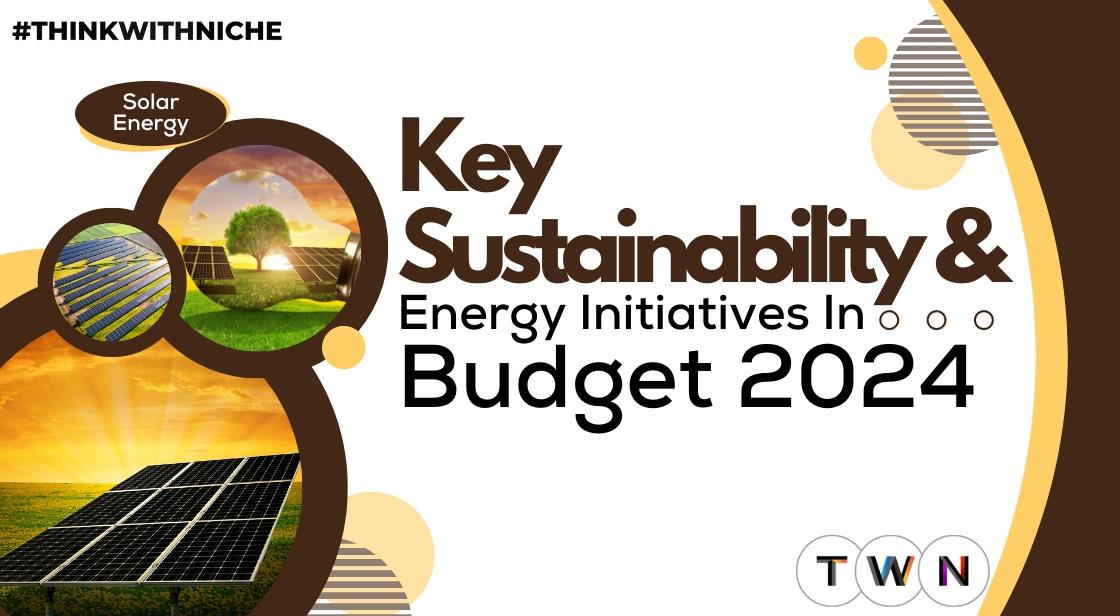Key Sustainability and Energy Initiatives in Budget 2024

Blog Post
As the urgency to address climate change continues to escalate globally, India’s Budget 2024 stands as a critical benchmark for the nation's commitment to sustainability and energy transformation.
With a series of groundbreaking initiatives, the interim budget reflects a strategic approach to not only mitigate the impact of climate change but also accelerate the shift towards a sustainable energy future. Given the recent spate of climate-related disasters, this budget is particularly timely and significant.
Presented by Finance Minister Nirmala Sitharaman, the interim budget for 2024 has introduced a suite of ambitious measures designed to address various facets of India's energy and environmental challenges.
From a transformative rooftop solar initiative to substantial investments in electric vehicle infrastructure and cutting-edge green technologies, the budget outlines a comprehensive strategy for fostering a greener economy.
Among the standout measures are the plans for expansive rooftop solarisation, enhancements to the electric vehicle ecosystem, and the pioneering offshore wind energy projects.
Furthermore, the budget has provided a substantial boost to the National Green Hydrogen Mission and introduced innovative coal gasification and liquefaction projects. Equally noteworthy is the support for bioenergy and biomass aggregation, which seeks to turn agricultural waste into valuable resources.
This blog explores these key initiatives in detail, highlighting their anticipated impacts and the potential they hold for shaping India’s energy landscape and environmental future. As India charts its path towards net-zero carbon emissions by 2070, the budget’s provisions represent crucial steps in this transformative journey.
Top Sustainability and Energy Measures from Budget 2024
Rooftop Solarisation: Revolutionizing Energy Access and Savings
One of the most talked-about initiatives in India's Budget 2024 is the ambitious rooftop solar programme, designed to provide free electricity up to 300 units per month to one crore households. This initiative is not only poised to significantly reduce energy bills, especially benefiting middle- and lower-income households, but it also opens up new avenues for economic and environmental benefits.
Economic Impact and Savings
For many Indian households, energy costs represent a substantial portion of their monthly expenses. By offering up to 300 units of free electricity, the government aims to alleviate this financial burden, making a significant difference in the lives of millions. The program is expected to lead to considerable savings on electricity bills, thereby increasing disposable income for affected families. Additionally, households that install rooftop solar panels will have the opportunity to generate surplus energy. This surplus can be sold back to the grid, providing an additional source of income and further enhancing the economic advantages of solar adoption.
Environmental and Social Benefits
The environmental impact of this initiative is equally noteworthy. By promoting the use of solar energy, the programme supports India’s commitment to reducing carbon emissions and combating climate change. Rooftop solar panels harness renewable energy, decreasing reliance on fossil fuels and reducing the overall carbon footprint. Socially, the initiative is likely to create new job opportunities in the solar energy sector, contributing to economic growth and sustainable development.
Electric Vehicle (EV) Ecosystem
Expanding EV Manufacturing and Infrastructure
The interim budget introduced several key initiatives to bolster the Electric Vehicle (EV) ecosystem in India, signaling a robust commitment to sustainable transportation. One of the primary measures is the substantial increase in subsidies and incentives for both manufacturers and consumers of EVs.
These financial incentives are designed to make EVs more affordable and attractive to potential buyers, aiming to drive up adoption rates. Additionally, the budget allocates significant funds for the development of EV manufacturing facilities, which will help meet the growing demand and support local industries. This includes investments in research and development to enhance battery technology and overall vehicle performance.
Enhancing Charging Infrastructure
A critical component of the interim budget's strategy is the expansion of EV charging infrastructure. The government has outlined plans to establish a comprehensive network of fast-charging stations across urban and rural areas. This expansion is crucial for addressing range anxiety, a common concern among potential EV owners. By increasing the availability of charging points, the government aims to make it more convenient for drivers to charge their vehicles, thus encouraging more people to switch to electric mobility.
Promoting Electric Buses for Urban Transport
In addition to personal electric vehicles, the budget highlights a focus on electric buses as a means to make public transportation more eco-friendly. The government is proposing grants and incentives for the procurement of electric buses, aiming to replace aging diesel fleets in cities. This move is expected to reduce urban air pollution significantly and enhance the overall quality of city life. By integrating electric buses into public transport systems, cities can achieve substantial reductions in greenhouse gas emissions and contribute to cleaner, more sustainable urban environments.
Recent Developments and Future Outlook
As of 2024, the Indian EV market continues to grow rapidly, with a significant increase in EV sales and a rise in the number of electric models offered by various manufacturers. Companies are investing heavily in expanding their EV offerings and improving battery technology. Furthermore, advancements in charging technology, such as ultra-fast chargers and wireless charging options, are becoming more prevalent. The government's continued support and investment in the EV sector are expected to accelerate this growth, paving the way for a greener future in transportation.
Offshore Wind Energy: Riding the Winds of Change
The interim budget has introduced a pivotal initiative for India’s renewable energy sector: viability gap funding for 1 GW of offshore wind energy. As per the Finance Ministry, this initiative is designed to leverage India’s extensive coastline to harness the powerful winds that blow off its shores. This move is set to push the boundaries of renewable energy, marking a significant step toward reducing dependency on fossil fuels and advancing sustainability goals.
Harnessing India’s Coastal Potential
India's coastline spans over 7,500 kilometers, providing ample opportunities for offshore wind farms. The 1 GW capacity funded under the new initiative is expected to accelerate the development of offshore wind projects, promoting cleaner energy generation. This funding aims to bridge the financial gap and make these projects viable despite their high initial costs. By supporting these projects, the government is signaling a strong commitment to transitioning to renewable energy sources and addressing climate change.
Recent Developments and Future Prospects
As of mid-2024, the global offshore wind industry has been witnessing substantial growth, with advancements in turbine technology and increased investments. India is poised to join this global trend, with several states exploring offshore wind potential. The government’s funding initiative aligns with its broader climate goals, aiming for a significant increase in renewable energy capacity by 2030.
The offshore wind energy sector's development not only contributes to reducing greenhouse gas emissions but also has the potential to create job opportunities and stimulate economic growth. As India moves forward with this initiative, it is expected to position itself as a key player in the global renewable energy landscape, harnessing the full potential of its coastal resources.
National Green Hydrogen Mission Boosted in Interim Budget
India’s interim budget for 2024 has given a substantial boost to the National Green Hydrogen Mission, increasing its allocation to Rs 600 crore from Rs 297 crore in the previous year. This significant enhancement underscores the government’s commitment to making Green Hydrogen a cornerstone of the nation’s energy strategy. Green Hydrogen, produced through the electrolysis of water using renewable energy sources, is touted as a clean fuel alternative that could revolutionize various industries by reducing carbon emissions and reliance on fossil fuels.
The increased funding is expected to accelerate the development and deployment of Green Hydrogen technologies. This includes advancements in electrolyzer technology, which is crucial for cost-effective hydrogen production, and infrastructure development for hydrogen storage and distribution. The mission aims to create a robust ecosystem for Green Hydrogen, integrating it into sectors such as transportation, industrial processes, and power generation.
Strategic Goals and Future Prospects
The National Green Hydrogen Mission envisions a future where hydrogen becomes a major player in the global energy landscape. By investing in research and development, scaling up production capabilities, and fostering public-private partnerships, the mission aims to position India as a leader in the Green Hydrogen economy. This ambitious push aligns with India’s broader sustainability goals and its commitments under international climate agreements.
Recent Developments
Recent advancements in Green Hydrogen technology, coupled with the increased budgetary support, suggest a promising trajectory for India’s energy transition. The focus now is on building a comprehensive infrastructure to support the widespread adoption of Green Hydrogen and integrating it into existing energy systems. The mission also seeks to address key challenges such as the high cost of production and limited storage solutions, ensuring that Green Hydrogen becomes a viable and competitive option in the global market.
This strategic focus not only advances India’s energy independence but also contributes to global efforts in combating climate change, demonstrating the country’s dedication to sustainable and innovative energy solutions.
Coal Gasification and Liquefaction: A Sustainable Shift
India’s interim budget has introduced a strategic initiative to revolutionize coal utilization through coal gasification and liquefaction projects. By 2030, the country plans to establish facilities capable of processing 100 metric tonnes of coal annually. This ambitious move is set to redefine how coal is used in the energy sector, focusing on sustainability and reducing environmental impact.
What is Coal Gasification?
Coal gasification is a process that converts coal into synthetic gas (syngas) consisting mainly of hydrogen, carbon monoxide, and carbon dioxide. This syngas can be used to produce cleaner fuels, chemicals, and electricity. Unlike traditional coal combustion, gasification significantly lowers emissions by capturing carbon dioxide before it is released into the atmosphere. This process also enables the use of coal in a more environmentally friendly manner, potentially reducing the carbon footprint associated with fossil fuels.
Also Read: Decoding Union Budget 2024: A Roadmap for 'Viksit Bharat' (Developed India)
What is Coal Liquefaction?
Coal liquefaction involves converting coal into liquid fuels like diesel and gasoline through chemical processes. This method allows for the production of liquid hydrocarbons from solid coal, which can then be used in transportation and industrial applications. Liquefaction not only enhances the versatility of coal but also reduces dependency on imported oil and natural gas. By developing this technology, India aims to bolster energy security and reduce fuel import costs.
Benefits and Implications
The coal gasification and liquefaction projects are expected to play a crucial role in India's energy strategy by diminishing reliance on imported natural gas and reducing greenhouse gas emissions. These technologies align with the country’s commitment to cleaner energy sources and offer a pathway to more sustainable coal utilization. The integration of these processes into India's energy infrastructure could provide a significant boost to energy security and environmental stewardship.
By investing in these technologies, India is setting a precedent for cleaner, more efficient use of coal, which could serve as a model for other nations striving to balance energy needs with environmental responsibilities.
Bioenergy and Biomass Aggregation
Turning waste into wealth, the interim budget has also promised additional financial assistance for biomass aggregation. This, they explain, will help in creating a sustainable model for managing agricultural waste, promoting bioenergy production, and giving farmers a new revenue stream. By investing in biomass aggregation, the government aims to address several critical issues simultaneously: reducing agricultural waste, lowering greenhouse gas emissions, and boosting rural incomes.
Sustainable Management of Agricultural Waste
Agricultural waste, such as crop residues and livestock manure, often poses disposal challenges and environmental concerns. The interim budget's support for biomass aggregation focuses on converting these waste products into valuable bioenergy resources. This process not only helps in managing waste more efficiently but also reduces the reliance on fossil fuels. By turning agricultural waste into bioenergy, the initiative aligns with global sustainability goals and supports India's commitment to cleaner energy solutions.
Promoting Bioenergy Production
Bioenergy, derived from biological materials, offers a renewable and low-carbon alternative to conventional energy sources. The interim budget's financial assistance is expected to enhance bioenergy production capabilities by funding new technologies and infrastructure. This will facilitate the development of biomass power plants and biogas facilities, which are crucial for generating energy from organic waste. Increased bioenergy production contributes to energy security and reduces the carbon footprint of the energy sector.
New Revenue Streams for Farmers
Farmers stand to benefit significantly from the biomass aggregation initiative. By converting agricultural waste into bioenergy, farmers can create a new revenue stream from what was previously considered a disposal burden. The financial assistance provided will support the development of biomass collection and processing infrastructure, enabling farmers to participate in this growing sector. This added income not only improves their financial stability but also incentivizes sustainable farming practices.
Research and Development (R&D) in Green Technologies
In a nod to innovation, the interim budget allocated a whopping Rs 1 lakh crore for interest-free financing in “sunrise” R&D for emerging green technologies. This significant funding boost aims to foster breakthroughs in renewable energy and sustainable practices. By focusing on advancements in solar, wind, and hydrogen technologies, the government is positioning itself to support a transition towards a greener energy future.
This substantial investment is expected to accelerate the development of cutting-edge solutions that can reduce carbon emissions and enhance energy efficiency. It also provides a crucial financial cushion for startups and established firms working on pioneering green technologies. The emphasis on interest-free financing is designed to lower the barriers to entry and encourage more private sector participation in R&D initiatives.
Recent developments further underscore this commitment to green innovation. For instance, India has witnessed an uptick in private investments in green hydrogen projects and advanced solar technologies. The government’s support extends beyond just funding; it includes creating a robust infrastructure for testing and scaling new technologies, as well as fostering collaborations between industry and academia.
As these initiatives gain momentum, the real test will be whether they translate into tangible outcomes. If the government follows through on this promise, the funding could catalyze a wave of innovation, driving India closer to its net-zero goals. Whether this will ultimately result in a greener and more resilient future for its citizens remains to be seen, but the initial steps certainly set a promising stage for transformative change.
You May Like
EDITOR’S CHOICE












